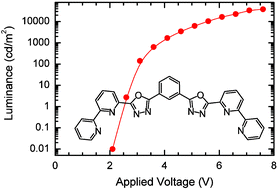Bipyridyl oxadiazoles as efficient and durable electron-transporting and hole-blocking molecular materials
Abstract
We have demonstrated new and efficient electron transporting (ET) and hole blocking (HB) materials for organic light-emitting devices (OLEDs). The bipyridyl-substituted


 Please wait while we load your content...
Please wait while we load your content...